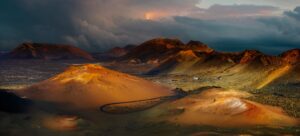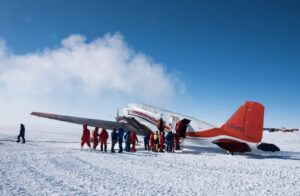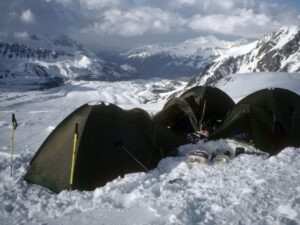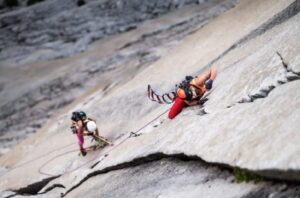The second in our two-part series, Too Wild looks at a selection of countries and regions where the primary danger is the environment. Whether it is extreme weather events, curious apex predators, or remote, rugged terrain, these places require careful preparation.
Weather
Meteorological forecasting is a fairly new. The first official weather forecast was only published in 1861. Four years later, Robert Fitzroy, the founder of the UK Met Office and a pioneer of weather forecasting, took his own life. His forecasts were quite accurate, yet he faced skepticism and ridicule. Today, 155 years later, some remain suspicious about weather forecasts.
Admittedly, predicting the future is tricky, but we’re better at it than ever before. Nowadays, no elite mountaineer would dream of taking on a major peak without a meteorologist on speed dial.
So, where in the world should we most closely monitor the seven-day forecast?
Vanuatu
Not what you were expecting? To all appearances, Vanuatu is an idyllic Pacific Island nation, and the picture-postcard beaches don’t look threatening on Google. Unfortunately for the roughly 300,000 inhabitants, the United Nations’ Natural Disaster Risk Index ranks Vanuatu as the most at-risk country on earth.

Vanuatu doesn’t look dangerous. Photo: Shutterstock
The Index examines vulnerability and exposure to natural disasters: volcanic eruptions, droughts, earthquakes, floods, storms, and rising sea levels. Vanuatu’s islands feature active volcanoes and regular earthquakes. The islands’ small size means that they are also extremely vulnerable to typhoons, storms, and flooding.
On top of this litany of threats, Vanuatu is ill-prepared to cope. Japan, also beset by natural hazards, most notably regular earthquakes, has developed shock-proof infrastructure and trained its population on how to respond in an emergency.
Faced with identical disasters, Vanuatu is much more vulnerable. In an interview with the current affairs site DW, Jörn Birkmann, the scientific head of the World Risk Index, uses sanitation to indicate the scale of the problem. “In good times,” Birkmann points out, “just 57 percent of Vanuatu’s citizens have access to sanitation and sufficient sewage disposal.”
The Philippines and Indonesia
Tonga takes the second spot on the risk index, with similar problems to Vanuatu. However, it is the larger Pacific nations that endure the most natural disasters in the region. Both the Philippines and Indonesia place in the global top five for natural disaster frequency. It’s not a promising sign when you sit astride a seismic strip called the Pacific Ring of Fire.

Mount Merapi, Indonesia. Photo: Shutterstock
Though both countries cope better than the smaller Pacific nations, their huge populations lead to potentially grim death tolls. Between 2000 and 2016, the Philippines lost 23,000 citizens to natural disasters. Indonesia has suffered many of the same storms and earthquakes. The 2004 tsunami took approximately 170,000 lives in Indonesia, the 2018 Palu earthquake another 4,340.
The United States, China, and India
Alongside the Philippines and Indonesia, the U.S., China, and India round out the top five most disaster-hit countries. Together, they accounted for a whopping 30.1 percent of disasters in 2016! Their presence is no surprise. Each country is a sub-continent in its own right; huge territories with long coastlines and varied climates.

Photo: EMDat.be
India has the highest fatality rate of the three, though statistics from China should probably be taken with a pinch of salt.
You would think that the U.S. would deal best with natural disasters. However, even in the richest nation on earth, death tolls can be massive. Hurricane Katrina took 1,833 lives and Hurricane Maria another 3,057 lives, mainly in the American territory of Puerto Rico. Fingers crossed that the Yellowstone super-volcano has a few years left on its timer…
In total, over the last 20 years, natural disasters have killed 1.23 million and affected four billion. A rise in average global temperature is predicted to increase the frequency of natural disasters.
Wildlife
ExplorersWeb has previously deep-dived into the world’s dangerous wildlife, covering snakes, crocodiles, insects, big cats, and polar bears. But which countries pose the highest wildlife risk?
India
India has far and away the most wildlife deaths every year. This is partly due to its massive population, yet this doesn’t tell the entire story. The U.S., with roughly one-quarter of the population of India, averages eight wildlife-related deaths a year. India averages roughly 500 deaths a year from human-elephant conflicts alone (and 90 elephant deaths too).
Despite dramatic stories about man-eating tigers and the country’s status as the last bastion for the species (70 percent of the global population), deaths from the big cats are quite rare, averaging around 40 per year.
I’ve tracked tigers on foot in neighboring Nepal. Despite a few scares, including a hasty, inelegant scramble up a tree (which would undoubtedly not have protected me in the slightest), the world’s largest cat preferred to keep its distance. A Nepali forest ranger summed up the tiger’s secrecy and preference for avoiding humans: “For every time I’ve seen a tiger, I have been seen 100 times.”
That said, consider this: a 50kg cougar can kill you, and a tiger averages 300kg.

A very distant tiger in Nepal. An appropriate distance for safety, inappropriate for my camera at the time. Photo: Martin Walsh
India must perform a difficult balancing act: Protect its diverse wildlife but minimize human-animal conflict. Giving megafauna adequate space, away from human interference, is key. India’s tigers once numbered in the hundreds of thousands; now just 1,700 remain.
Australia
In our Dealing with Snakes article, we explained that the vast majority of the 3,000 species in the world are harmless to humans. Only about 300 merits the label “venomous.” Australia is home to 20 of the 25 most dangerous, including the most venomous of all, the inland taipan. This is enough to mark Australia down on a list of places where it’s worth checking your boots before putting them on each morning.
However, snake deaths are actually infrequent. Between 2000 and 2010, there were 254 confirmed deaths caused by animals in Australia. Horses, dogs, and cows were responsible for 137 of those. The top wild perpetrator was the fearsome kangaroo, which caused 18 deaths. Snakes only accounted for 14 deaths during the entire decade. Australia’s snakes may be dangerous, but you’d be extremely unlucky to die from one. Sri Lanka has the most snakebite fatalities annually.

A highly venomous ruby-eyed green pit viper from southern Vietnam, showing the pit viper’s characteristic flat, triangular head. Photo: Martin Walsh
Canada
The most dangerous animal in Canada is actually the moose, not from rutting bulls charging but from highway collisions. The tall, spindly-legged moose is at the perfect height to fly through your windshield. As befitting a country of its size, with so much remaining wilderness, Canada does have a few minor issues with wildlife: Did you know that there are rattlesnakes, scorpions, and black widow spiders this far north?
And although cougars will stalk and kill humans on very rare occasions, there is really only one animal to worry about: the polar bear. Spread across the north, polar bears do occasionally “test” arctic travelers, but the Arctic is so big and polar bears so spread out that encounters are rare.
One exception is the Torngat Mountains National Park in northern Labrador. Churchill, Manitoba is more famous for polar bear viewing, but that’s only for a few weeks in late fall, as the bears collect to wait for Hudson Bay to freeze. The Torngats have them year-round.
If you take a paddle down the coast, as our editor Jerry Kobalenko did one summer, you might find yourself practically tripping over them. A 2006 census put the bear population at around 140, heavily concentrated along the 230km coastline.
That’s one 700kg apex predator every two kilometres. The population is supposedly double that now. During a six-day period in the Torngats, Kobalenko had more close encounters with polar bears than in all his previous arctic expeditions combined. To make matters worse, only Inuit are allowed to carry firearms in a northern national park. You’d better be good at bluffing.

An all-too-curious polar bear.
Disease/ Infrastructure
As we discussed in Dealing with Insects, the deadliest creature in the world is the humble mosquito. Of course, it’s not the critter itself that’s killing a million people a year, it’s the cargo.

A mosquito feeding. Photo: www.pratheep.com
In 2019, the World Health Organization recorded 229 million cases of malaria. There’s also tuberculosis, HIV, cholera, hepatitis, and many lesser-known communicable diseases. Which countries host the brunt of these infections?
Nigeria
A huge population and developing economy make controlling malaria in Nigeria a tough task. In 2019, Nigeria accounted for a shocking 23 percent of all malaria infections worldwide.
Nigeria also has a very young population, with a median age of just 18. Malaria is most dangerous in children under five, accounting for 67 percent of all deaths, so the population demographics are not in Nigeria’s favor.
The Democratic Republic of the Congo
DRC is a hard country. It featured in our Dangerous Places Part One and has just been in the news after the killing of six Virunga National Park rangers last week.
In the DRC, both the volume and variety of problems make it so dangerous. There is ethnic violence, corruption, and lawlessness. On top of these issues, the country ranks second in malaria infections (11 percent of the global total), has suffered from cholera outbreaks (in 2017, a particularly virulent outbreak caused 1,145 deaths), and struggles to control tuberculosis infections (270,000 infections in 2018). From hospitals to roads, the country’s infrastructure is in a rough state. Given the vast size of the country, the DRC is a dangerous place to get sick.






